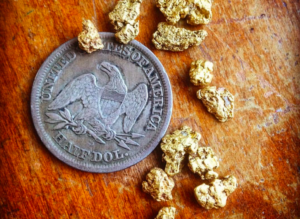
The Mokelumne River winds its way 95 miles through Northern California, from the central area of Sierra Nevada and all the way to the Sacramento-San Joaquin River Delta. The river watershed drains roughly 2,143 square miles across multiple counties, namely Alpine, Amado, Calaveras, San Joaquin and Sacramento in California. Divided into the Upper and Lower River by the Camanche Dam, the Mokelumne takes its rather unique name from a Miwok phrase that means “People of the Fish Net”.
Early Gold Discoveries
It was in the late 18th century when European explorers began their expeditions in this area of California, and the name Mokelumne (or Muquelumnes, to be exact) was noted down in 1817 by the Spanish missionary Narciso Duran.
In 1830, various settlements were established but gold was only found almost two decades later in 1848 when the California Gold Rush began in earnest. The earliest documented discovery was made by Mr. Charles Weber. Due to the tremendous flood of mining activity across all of California, he did not stay long in the area. He moved on to San Joaquin County where he established one of the earliest supply centers of the area in what is currently known as Stockton City.
It was a smart move, shifting from gold mining to mining supplies, considering that the need for his products became consistent and plentiful during the height of the California Gold Rush.

It was said that the gravels of the Mokelumne River were so rich that gold miners risked starvation rather than leave their claims to restock supplies. While it may not be quite that rich today, modern gold prospectors in the Sacramento and Stockton area still head up the canyon to search for gold.
Mining Camps Spring Up
Mokelumne River placer mining was greatly helped by having Stockton as a supply center nearby. Various mining camps were established at Lancha Plana, Winters Bar, Oregon Bar, James Bar and Middle Bar. Mining interest and activity continued consistently through to 1850.
A few years later, Mokelumne Hill was established as a town in Calaveras County and grew to become the largest town in the area. It remains quite well preserved today, and visitors can glimpse the gold rush-era establishments such as Hotel Leger and the Historical Society.
What really turned Mokelumne Hill into a boomtown, however, was a major gold find by Samuel W. Pearsall. Prior to his find, much of the activity was concentrated in Big Bar, full of Mexican and American settlers from the central valley.
Pearsall was part of Colonel Jonathan D. Stevenson’s Regiment of New York Volunteers, who had been mustered out of service and looking for gold. The story goes that he was directed to the north side of Stockton Hill by the miners who did not want him to muscle in on their claims. While they thought there would be no more gold to find there, the area turned out to be richer than Big Bar. It was so rich that it drove most of the activity there, and miners had to be limited to 16 sq. feet per claim. Each claim could yield up to $20,000 in various large nuggets.
As a result of the constant and rich yield of the land, Mokelumne Hill became Calaveras’ county seat up to 1866. It was only towards the end of the 1860s when gold production began to taper, and the town’s population dwindled.

The Mokelumne River is now a popular site for fishing, rafting, and a wide array of outdoor activities… but in the 1800s it was all about one thing… GOLD!
Mines of Calaveras County
Various districts within Calaveras County saw great yields from placer mining in the river. The Camanche district to the northwest saw an estimate of 1 million ounces recovered through the use of bucket-type dredges and draglines. Campo Seco was another strong producer, with the Pern Mine (operational between 1899 to 1919) producing both gold and copper.
Campo Seco became the commercial center of the area, flourishing until various fires ravaged the town and mining activity lessened. There were a few attempts to restart mining in the 1940s by the Eagle-Shawmut Mining Company and the Penn Chemical Company, but both of these were short-lived.
Gold Panning and Sluicing
These days, the casual prospector can still head out to Mokelumne’s banks for an enjoyable and profitable adventure. Some of the more popular spots for prospecting are Roaring Camp, which was in fact once a camp for 49ers but due to its inaccessibility at the time, saw minimal panning activity. Today, Roaring Camp is an established recreation facility that allows gold panning and is equipped with camping facilities as well as prospecting cabins. Many people come here for its scenic views and guided tours.
Another popular location is the Middle Bar Bridge area, which is located off Electra Road near Middle Bar Bridge (right above Highway 49). Similar to Roaring Camp, this is a very scenic place that many enjoy swimming, hiking and rafting through, along with prospecting activities.

When miners first arrived at the Mokelumne River, they found extremely rich gravel loaded with gold. Some locations were as rich as anywhere in California.
Gold is widespread across the Mokelumne River basin. Countless streams that feed into the river will also produce decent gold, and this can be a productive area to explore too.
Coarse gold can be found by metal detecting gulches and benches high above the river canyon. Most of the river gravels have been worked (and reworked) hard over the past century. You can still find gold in the river, but exploring the overlooked sites can be more productive than working the more obvious areas.
Whether it’s the precious minerals you unearth or the fascinating stories that unfold, those who have a golden interest will always find treasure. Many mining towns that boomed back in the day have a trove of secrets for the adventurous prospector, and Mokelumne is no exception. If you happen to visit any of these locations, be sure to have some hiking or picnic gear handy, as the views will surely be astounding.
The Alleghany District | Super Rich Gold Mines of California
